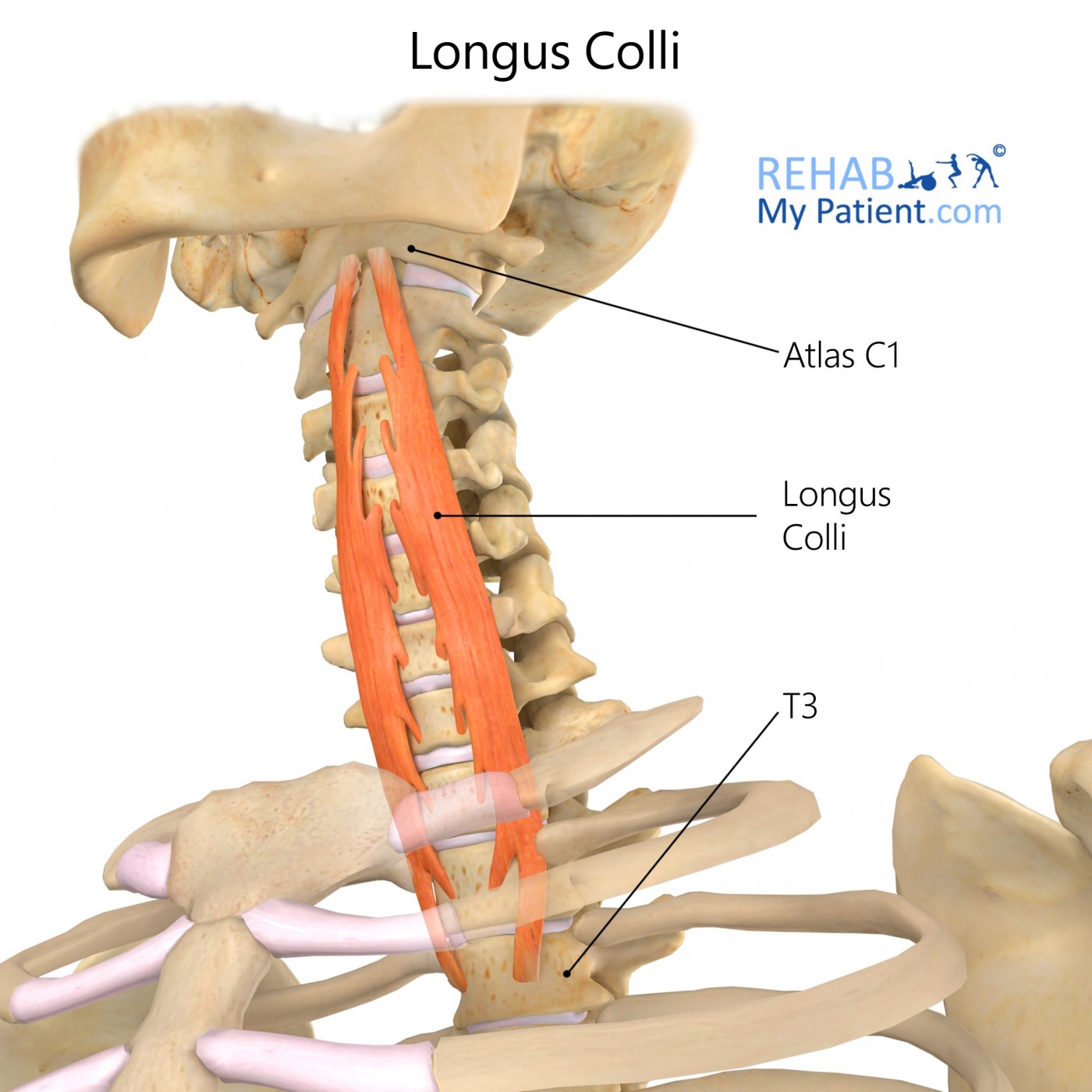
General information
Longus colli is located on the anterior surface of the vertebral column, between the atlas and the third thoracic vertebra.
Literal meaning
The long neck.
Interesting information
Longus colli is a long skeletal muscle of the neck that is responsible for flexing the neck and the head.
The longus colli is part of a group of muscles called the deep flexor muscles, which provide neck stabilization. Whiplash is the most common cause for injury to the longus colli. During whiplash, the jerking back of the head may cause trauma to the cervical spine and can slightly tear or dangerously rip several muscles in the neck including the longus colli. Muscle spasms can result from whiplash and may alter the curvature of the spine. Location of pain is on the backside of the neck. Treatments include the use of analgesics, anti-depressants, muscle relaxants, and cervical collars.
Origin
Transverse processes of C-5 to T-3.
Insertion
Anterior arch of the atlas.
Function
Flexes the neck and the head.
Aids the sternocleidomastoids in holding the head up.
Nerve supply
C2-C6
Blood supply
The ascending pharyngeal artery and the vertebral artery.

Relevant research
Ultrasonography (US) procedures assessed the size of the longus colli muscle (LCM) in patients with chronic neck pain and healthy subjects. US showed that in patients with pain, the LCM had smaller dimensions than those of the healthy subjects. Atrophy to muscles from neck injury may cause the muscles to shrink. To see if exercise therapy intervention has an effect on the size of muscles, the US technology may be a viable option for monitoring it.
Javanshir, K, Mohseni-Bandpei, M, Rezasoltani, A, Amiri, M, Rahgozar, M. (2011). “Ultrasonography of longus colli muscle: A reliability study on healthy subjects and patients with chronic neck pain”. Journal of Bodywork & Movement Therapies. 15, 50-56.
Anterocollis is a symptom of cervical dystonia (CD), which causes involuntary flexion of the head. Injection of botulinum toxin is the current treatment for CD, but exploration of more precise injection techniques will help enhance treatment. Since superficial cervical flexors play a role in the flexion of the spine, it is plausible that deep flexor muscles also play a role. Botulinum injections to the LCM showed improvement in pain and motor improvement in two out of ten patients. Some patients exhibited mild symptoms of dysphagia and sore throat.
Glass, G, Ku, S, Ostrem, J, Heath, S, Larson, P. (2009). “Fluoroscopic, EMG-guided injection of botulinum toxin into the longus colli for treatment of anterocollis”. Parkinsonism and Related Disorders. 15, 610-613.
Longus colli exercises
Strengthening of a weakened longus colli is possible through performing these exercises.
The chin tuck exercise
Begin by lying on the floor with a neck support. Without bending the neck, tuck the chin in and hold for five seconds. Now push the head into the floor without bending the neck, hold for 5 seconds. Repeat this exercise twelve times for two sets. Perform this exercise three times weekly.

Head nods
In the same position as a chin tuck, without the pillow, tuck the chin in. Keeping the head straight; raise the head off the floor about three or four inches. Hold position for twenty seconds. Repeat this exercise by completing two sets of five repetitions. Perform this exercise three times a week.
Sign Up
Sign up for your free trial now!
Get started with Rehab My Patient today and revolutionize your exercise prescription process for effective rehabilitation.
Start Your 14-Day Free Trial